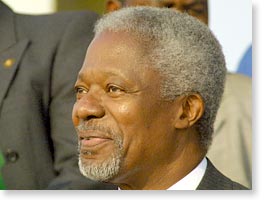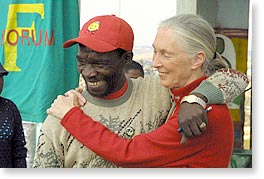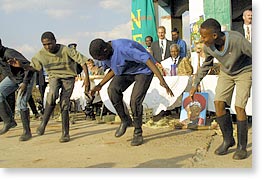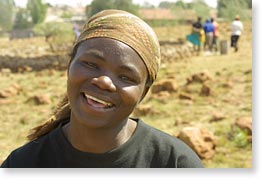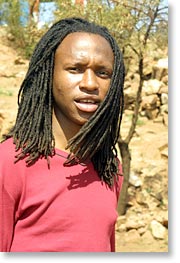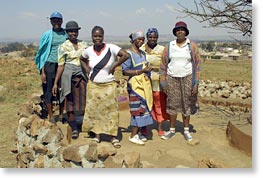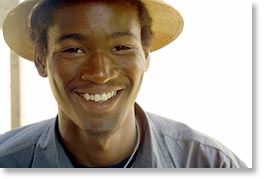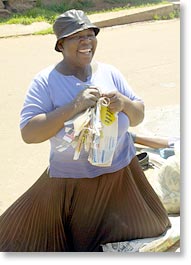|
Interview with Mandla Mentoor
The Soweto Mountain of Hope: Making People Free Soweto, South Africa
Mandla Mentoor is the "founder, member and the director of the Soweto Mountain of Hope. We are operating in Chiawelo, just next to the Chiawelo Council Administration offices, as well as the Chiawelo Post Office. We started this project last year in December and we are hoping that this will be a real icon and a beacon of hope." This interview was conducted September 4, 2002 by Nic Paget-Clarke for In Motion Magazine during the United Nations World Summit on Sustainable Development in Johannesburg, South Africa.
In Motion Magazine: What was the original organization, the Amandla Waste Creations (AWC)? When did that start, what was that about? Mandla Mentoor: This project is a brainchild of a project that I started in 1990 called Amandla Waste Creations which was aimed at cleaning our environment, especially following the problems that were created by our rent boycotts as communities during the ’80s. Our open spaces in Soweto were covered with waste and were already turning into illegal dumps. So it is out of that that I saw an opportunity of bringing together young people and started encouraging them to help clean the environment. That project has grown since then. In 1994, I launched a project within the project called Children Loving Nature which caters for children between the ages of five and sixteen and what they focus on, the environment. The idea of that is just for me to start creating and developing a core of young people that will understand environment not only as littering and dumping, a young core of leaders that will understand environment as their dwelling area in terms of the air, the water, the soil, the biodiversity that surrounds them. These children are the children that hosted, during this Summit, the International Children Earth Summit that has drawn children as far as from India, the U.K., Lesotho, Ethiopia, as well as America. From a no-go area to an eco-cultural environmental center In Motion Magazine: Can you explain how the water tower got converted and why? Mandla Mentoor: Yes. The Soweto Mountain of Hope was a barren land that was covered by waste and that was very dangerous in the past. This area was a no-go area for some years. No community member, not even a small child or any woman in the community would have ever dared to come in, relax here, and have a breather. It is out of that that we had started realizing that this area could become a resource. And so, following the implementation of Amandla Waste Creations, by the year 2001 Amandla Waste Creations had ten departments in it – culture, dance, music, theater, art, land and all the other departments. The idea of working here was to turn this mountain into an eco-cultural environmental center that will house all these departments and to turn it into a learning center for all the communities in South Africa, especially young people and women drawn out of Soweto. In Motion Magazine: We are sitting on this hill and there’s hundreds of people. There’s hundreds of people on this hill. That’s pretty amazing. Can you explain how it’s become so popular? Mandla Mentoor: Yes. I must say that it took us something like ten years, honestly, trying to battle to get this piece of land. I don’t blame anyone for that long period. I understand that we are a new democracy and we had to give our time to transform all the bad policies, especially the Land Act. We are proud today that we have been given this land on a nine and a half year lease by our government. The question is, why are there hundreds of people around here. I must say that also within that process we made it our duty to actually zoom out to communities and start marketing this idea, and start also selling the idea that this dangerous mountain should be turned into a dwelling area. It required a lot of public participation to put us where we are. I am very proud to say we are boasting plus minus 250 volunteers who are not only encouraged by our talks but also encouraged by the call of our president, President Mbeki when he called for Letsema (editor: the spirit of Letsema and Vuk'uzenzele -- Arise and Act) In Motion Magazine: I was told that people used to even jump off the tower and kill themselves, but now there are things growing around the tower. Can you talk about that? Mandla Mentoor: It is true that this tower has been lying there barren all the years and was very unsafe. We understand as a project, we learned as a project, that quite a few people had tried to jump over there, the tower, but I’m happy that today the area is going to be very secure and instead of it being a danger to the society, the project has taken it and we are trying to make it as safe as possible. The area which is the tower, that has been so dangerous, today is going to be turning into a dwelling area that will be shared by the entire world to make this area a beacon of hope. A contribution to this democracy In Motion Magazine: You started in 1990 -- that was during apartheid. What was that like? Mandla Mentoor: I must say that it was very difficult because one could not speak freely around the concept that is got. If you look into the concept and if you listen to the concept that you’ve shared with the people, especially our tourists and all our members here, that type of concept is a very radical concept, and surely, if it was during the apartheid era we don’t think that (apartheid) would have put us where we are today. We are very proud that our little democracy is starting to deliver and ours is just to make our own little contribution as a community, to enhance it and even strengthen it even more. We are taking that communities out there will surely learn out of this and use this as a role model that can be taken to all the provinces, to all townships, to all communities that are in need. In Motion Magazine: Can you talk a little about what apartheid was like in Soweto? Mandla Mentoor: Yes, I must say that apartheid was real bad news, especially that people had no say, especially that young people could not freely intermingle and talk of things the way they effected them. I was a young person during apartheid. I know exactly what it meant. I remember there was a time when I was actually pounced upon by more than a thousand students drawn from a few high schools who were being given wrong information about myself that I was a member of a gang that was fighting against students. I am happy that all those students were convinced after they’d spoken to me that I was just another comrade who was trying to do his best to assist and contribute to the struggle. I must say that apartheid was not good news at all. It is gone now, we’ve buried it, we don’t even want to talk about it. I feel very bad that there are still people who always look at apartheid and use it as an excuse and say, “Yeah, it’s due to apartheid that we are what we are.” I’m happy that within the group that we are working with we are conscientizing them and changing their mindset and their perceptions, to forget about looking and blaming apartheid but look at the present situation now and ask themselves of -- what is it that they can do to make a statement? What is it that they can do to make a contribution to this democracy? Environmental justice is also part of politics In Motion Magazine: Can you tell me a bit about the Environmental Justice Network and Forum (EJNF)? Mandla Mentoor: Environmental Justice Network and Forum is an organization that has actually helped me a lot to start realizing that environmental justice is also part of politics. It’s a way of conscientizing people around issues of environment that are not gelling well with communities. Environmental Justice Network and Forum is a national NGO that is constituted in about eight provinces in South Africa and it boasts something like plus minus 400 member organizations of which most of them are community-based organizations. Amandla Waste Creations as well as SOMOHO today are part of those community-based organizations that are within EJNF. I must say that we thank the support of EJNF in terms of helping to capacitate our members around issues of environment and we applaud EJNF’s work throughout the provinces in South Africa. United Nations Secretary General Kofi Annan In Motion Magazine: What is the significance of the fact that the Secretary-General came here? Mandla Mentoor: I must say that the significance of the Secretary General coming here is that what pleases most about this is that communities have gone out, communities are no longer folding their arms and waiting for manna to fall from heaven. Communities, especially women, young people, have gone out and are busy working without any pay, without any salary to turn this mountain into a better place for everyone and we hope that the coming of the Secretary General to this mountain gives it a real meaning in terms of it being a beacon of hope. It is not long a hope for only the communities of Soweto, but it is hope for all the communities at each and every corner of the world. Communities in Nepal, communities in India, communities in Malawi, communities in Nigeria, communities in Somalia, and communities all over the world are going to learn out of this and we are hoping that the energy that grows around here and that boils around here will catch up with everyone that touches base on this mountain, all that is shared, the stories of this mountain. In Motion Magazine: You grew up in this neighborhood. Can you talk a little about why you decided to start working on this project. Mandla Mentoor: Yes, it’s true. I was born and bred in Soweto, but not this part of the township. We were living on the other side which is about three, four, five kilometers away from here. It was only 1986 when my father swapped houses with the people that lived near this mountain. I must say that when I came here, I saw this beautiful mountain with this beautiful tower and I started talking around with the young people, with women. I had contact with women organizations, youth organizations, youth clubs and was just asking, “What we can do about this?” And seeing that people had no idea but they loved to see something happening, I made it my commitment and prayed day in and day out so that God could give me power and lead this process. I feel very honored and blessed today that that dream has become reality. In Motion Magazine: What do you think about what has been going on at the United Nations conference? Mandla Mentoor: I must say that I’m not a politician to start with and what I realize is that the whole forum has turned into a political battleground. What we are only hoping as communities, especially communities in Soweto, and all over the world, we are hoping that the process at NASREC will actually put people at the center of each and every debate that they embark on so that whatever that is being discussed, whatever resolutions or declarations that will come out of that are actually centered around the people and their needs. In Motion Magazine: Why do you think it is important to use art both in the construction of the project and also in the teaching with the young people, the different departments? Mandla Mentoor: We are using art a lot in our program because we feel that art allows us our free brains. Our young people have been bottled up for years and so our women too. What we are trying to do, using art as the anchor of the project is just to start allowing freedom of the mind, freedom of the hand, freedom of speech and freedom of everything to young people as well as women. We believe immediately we achieve that objective then we shall have achieved to make people free, to make people self-reliant, to make people really think or not because one of the things that has killed us during apartheid was that the indigenous knowledge of the people had been buried. It’s not considered. But today the style and the concept that we are using on this mountain, we are encouraging people to use their own free minds, free hands and also use that based on their indigenous knowledge of their understanding of sustainable development. As you can see around here there is no caterpillar. There is no earth-moving equipment. It’s people moving rocks from one place to the other, building their own terracing, and also building their own circles, using paper-crete and rocks. And to us there is no better way of making people free as that way. |
||||||||||||||||||||||||||||||||||||||||||||||||||||||||
| Published in In Motion Magazine, June 8, 2003 | ||||||||||||||||||||||||||||||||||||||||||||||||||||||||
If you have any thoughts on this or would like to contribute to an ongoing discussion in the  What is New? || Affirmative Action || Art Changes || Autonomy: Chiapas - California || Community Images || Education Rights || E-mail, Opinions and Discussion || En español || Essays from Ireland || Global Eyes || Healthcare || Human Rights/Civil Rights || Piri Thomas || Photo of the Week || QA: Interviews || Region || Rural America || Search || Donate || To be notified of new articles || Survey || In Motion Magazine's Store || In Motion Magazine Staff || In Unity Book of Photos || Links Around The World NPC Productions Copyright © 1995-2018 NPC Productions as a compilation. All Rights Reserved. |




